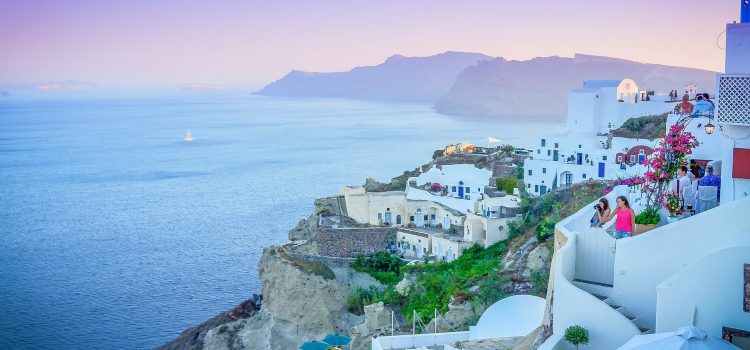13 Of the Best Perks of Flying Business Class
We’ve all daydreamed about what it’s really like flying Business Class, while making that slow, step-by-step shuffle through Business Class to Economy. It teases with its luxe, spacious cabins and cushy comforts – some folk already settled in and sipping on a token ‘welcome’ of bubbling champagne, ready for their Business Class flight.
Lucky them, right? Not quite. Business Class travel isn’t limited to realms of imagination (or wishful thinking for a free upgrade) and nor is it reserved for the ‘lucky few’.
Here are 13 perks of flying Business Class on the best airline business classes that’ll make you understand why it’s absolutely worth every penny.
Business Class Travel Before You Fly
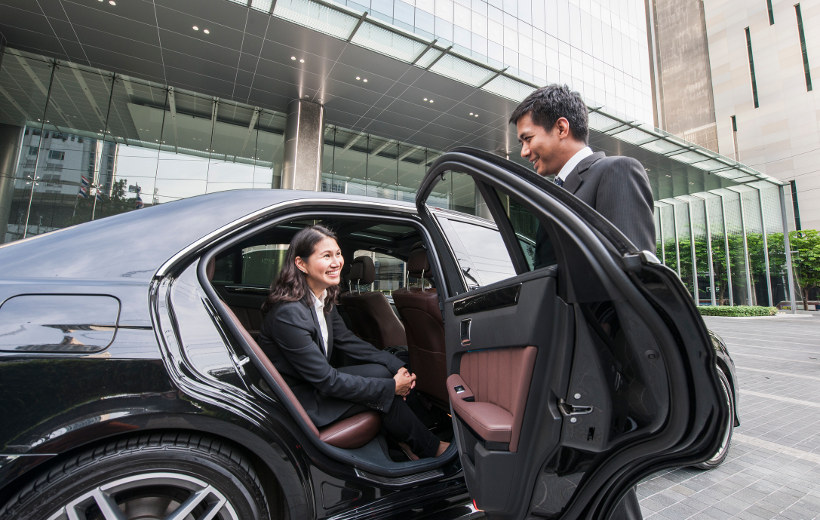 Arrive to the airport on time and in style with a hassle-free chauffeur service available with more Business Class airlines.
Arrive to the airport on time and in style with a hassle-free chauffeur service available with more Business Class airlines.
Chauffeur service
The benefits of flying Business Class begin before you even leave the house. For many airlines, a chauffeur service will ferry you from your own front door to the sliding doors of the airport terminal, completely free of charge.
Expect private transfers with state-of-the-art vehicles and professional drivers at the wheel. Select Business Class guests on Virgin Australia’s international long haul services may be eligible for an extra special limousine service.
Priority check-in for Business Class guests
So you’ve arrived at the airport with luggage in tow only to be greeted by massive check-in lines – not when you’ve got a Business Class ticket to collect. A dedicated check-in line makes you a priority, so you can skip the regular queue, receive prompt service and be on your way in a zippy.
To make it better, many airlines offer priority security screening for First and Business Class guests. If you’re flying with Etihad out of Abu Dhabi, the benefits extend to kerbside service and a designated airport entrance and check-in lobby exclusively for First and Business Class travellers.
Additional baggage allowance
Some of the best airlines offer additional check-in and carry-on luggage allowances to Business Class passengers, especially on international flights. On domestic carriers, where Economy passengers are limited to one check-in bag only, Business Class passengers can often have two, providing they’re under the maximum weight restriction. Weight restrictions also increase, for example, Emirates Business Class, Qantas Business Class, Etihad Business Class and Singapore Airlines Business Class passengers get a generous 40kg, however Virgin Australia Business Class passengers get two bags at 32kg each!
Premium lounge access
Automatic entry to private airport lounges makes time spent waiting to board the plane count. These luxurious enclaves boast an array of comforts and practicalities. Comfortable seating, private sleeping and relaxation areas, shower facilities, concierge services and exclusive meal offerings ranging from buffets to a la carte dining offer a taste of the benefits.
If you’re travelling for business, you can remain efficient and productive in the Business Centre. Some airlines, including Etihad, Emirates and Qantas, even include pampering spas in their Business lounge areas. Cathay Pacific Business Class guests even get the choice of five unique Business lounges at Hong Kong Airport, where the top notch amenities even include a fresh noodle bar and authentic teahouse.
Flying Business Class
 A Business Class ticket means first on board.
A Business Class ticket means first on board.
First on board
When you upgrade to Business Class, boarding is a breeze when you get to file into the plane first. Settle in without the crowds and receive priority service from dedicated flight attendants while the Economy Class guests are still waiting at the gate. Say hello to your ‘welcome’ champagne.
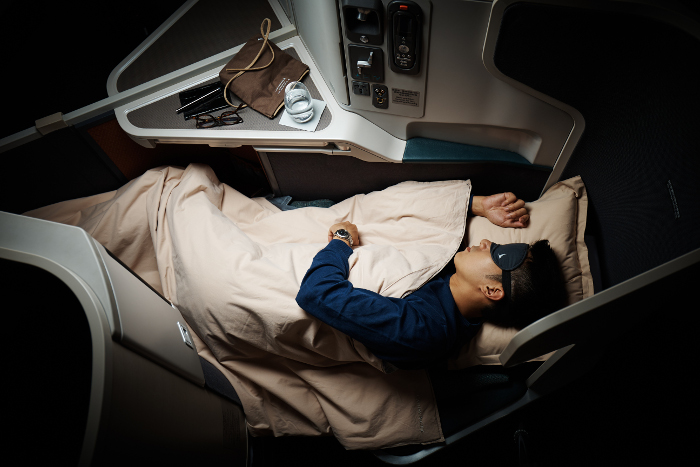 Cathay Pacific Business Class beds transform to full-flat for maximum comfort and rest. (Image: Cathay Pacific)
Cathay Pacific Business Class beds transform to full-flat for maximum comfort and rest. (Image: Cathay Pacific)
Better rest with Business Class beds
Considering you’ll be sitting for 10-plus hours, your seat counts big time. In Business Class, the seats come bigger and better to provide the utmost in passenger comfort. From recline seats to lie-flat beds and private suites, the specific details vary with each airline.
Most airlines however offer a turn-down service, bedding and slippers as well as luxury loungewear and an amenity kit filled with designer products. Business Class seats on Etihad, and Qantas’ award-winning Skybed even tout a unique in-built massage feature.
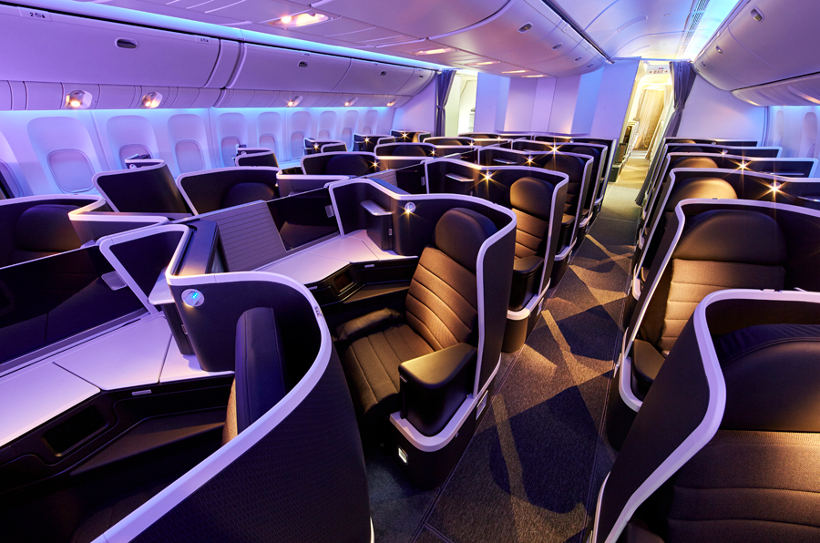 Virgin Australia’s ‘The Business’ offers modern comfort and a private, spacious inflight experience. (Image: Virgin Australia)
Virgin Australia’s ‘The Business’ offers modern comfort and a private, spacious inflight experience. (Image: Virgin Australia)
More space
Flying Business Class won’t leave you feeling huddled in by the person sitting next to you like Economy can. Pack away your belongings in convenient-to-access concealed storage compartments, stretch out those legs as far as you can and most of all, enjoy some personal space.
From being able to fit both a book and a meal on your table at the same time to feeling as though you have your own private area – depending on who you fly with – a little extra space goes a long way to a healthy, happy in-flight experience.
Fine food with inflight dining
Dread the thought of out-of-the-box aeroplane food? Drop that thought. Dining in Business Class is a culinary experience designed to entice. Award-winning menus crafted by famous chefs, an onboard cafe service and boutique wine lists are just the start. Emirates zeroes in on the finer details with Royal Doulton bone china plates and Robert Welch cutlery while Virgin Australia touts celebrity chef Luke Mangan as the mastermind behind the menu. All-round, food in Business Class just keeps getting better.
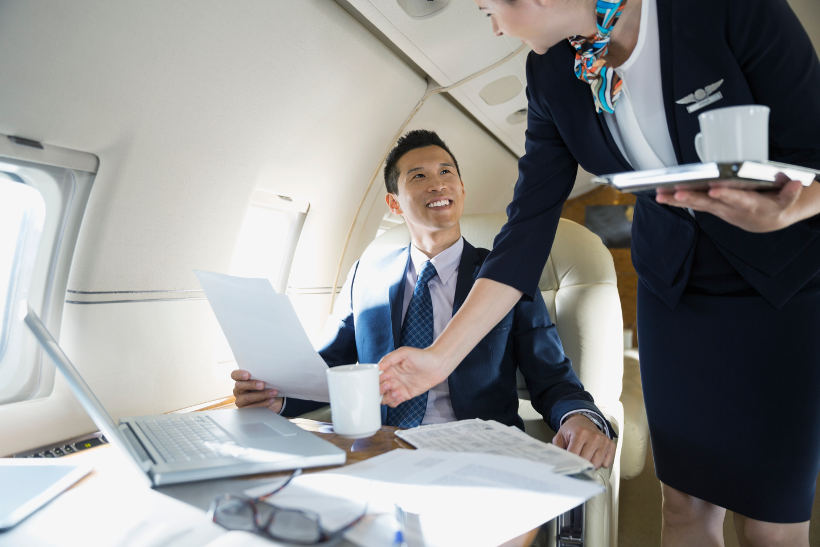 Eat and drink whenever you want with personalised service onboard Business Class.
Eat and drink whenever you want with personalised service onboard Business Class.
Service first
Whether it’s a light snack or a multi-course meal your stomach is grumbling for, another of the many perks of Business Class is that you get to decide exactly what you want and when you want it. Many airlines have dedicated Food and Beverage Managers that have trained in the world’s top hotels and Qantas is famous for its Sommeliers in the Sky. In short, you can expect only the best.
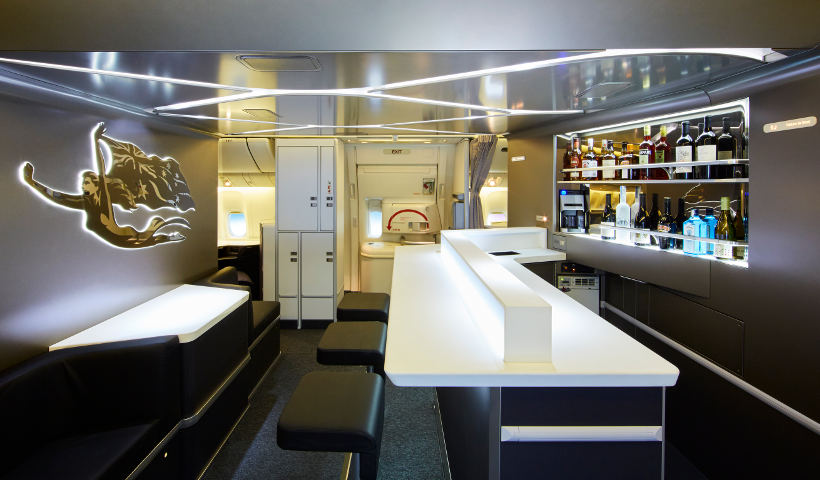 Business Class guests onboard Virgin Australia can enjoy the onboard Business Class bar. (Image: Virgin Australia)
Business Class guests onboard Virgin Australia can enjoy the onboard Business Class bar. (Image: Virgin Australia)
Business Class lounges onboard
As aeroplanes have grown in size so has the potential for new onboard spaces. Say hello to the age of in-flight lounges and bars – typically restricted to Business and First Class guests. On select flights with airlines such as Emirates, Korean Air, Virgin Australia and Virgin Atlantic, you can leave your seat behind to indulge in beverages at an exclusive stand-up bar area. Some offer snacks all the way up to five-star hors d’oeuvre standards.
Alternatively, on Qantas and Emirates A380 flights, head to the intimate, furnished onboard Business Lounge which is fully serviced. Suddenly that long haul journey doesn’t feel so long and draining after all.
Enhanced entertainment
For those who quite enjoy the inflight entertainment element of long haul journeys, know that it only gets better in Business Class. Enjoy exclusive access to extra channels as well as much bigger screens, which vary in size from airline to airline.
It’s also much easier to keep in touch with friends and family with a range of connection ports at your fingertips and on select flights, mobile or Wi-Fi connectivity from take-off to touch-down.
Work while you fly
While many airlines now offer onboard WiFi regardless of what cabin you’re in, and it’s becoming increasingly common to see USB plugs in seats, travelling in business class takes working in the air to the next level. Extra space at your seat, including a decent tray that can double as a desk, guaranteed in-seat power supply and USB ports make working in Business Class a breeze. Plus, the fact you can choose when you have your meals, and order refreshments as you please, means you can power through that project without interruptions.
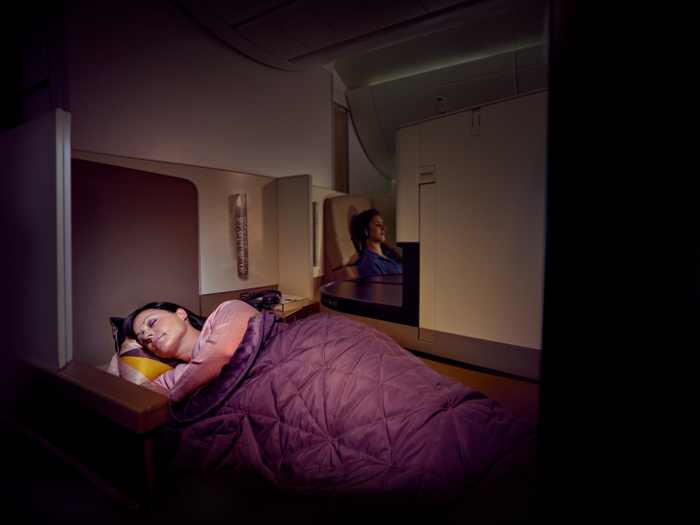 Arrive to your destination feeling refreshed after sleeping in the ultimate privacy and comfort onboard Etihad’s Business Class suites. (Image: Etihad Airways)
Arrive to your destination feeling refreshed after sleeping in the ultimate privacy and comfort onboard Etihad’s Business Class suites. (Image: Etihad Airways)
On arrival
Get off and go
Finally, you’ve landed. The last thing you need is to get caught up in the slow ensemble of passengers arranging their belongings to disembark. Thankfully, you will be among the first to leave the aircraft.
Once you speedily arrive at the baggage collection area, your bags too will be the first to appear on the conveyor belt. If eligible, a pre-booked complimentary Chaffeur Drive service will top off the arrival experience. When you fly Business Class, the service exceeds expectation, door-to-door.
What’s the difference between Business Class vs First Class?
These days, the best Business Classes are as good, or even better, than First Class once was, so what’s the difference? Many airlines now have many more seats in Business than First, with some having foregone First Class altogether.
On the airlines that still service First Class passengers, while Business Class seats can for the most part convert into a completely flat bed, and menus and entertainment are top notch, First Class is a whole different ballgame. Flying Etihad First Class you have your own one-room suite, appropriately named The Apartment, while an even higher class exists – the $20,000 three-room Residence! The Emirates First Class suite on the A380 has access to an onboard shower and spa. While on Qantas First Class you not only have a suite, but can enjoy a pre-flight pamper with a complimentary spa treatment in the First Class Lounge.
Talk to a Business Travel consultant about Business Class flights today.
7 Ways To Travel More Sustainably — An Optimistic Take
Despite some slow progress, travelling in more sustainable ways is getting easier. As travellers we have more ways to reduce our environmental impact, while more tourism companies are making the necessary changes to decrease their carbon footprint.
I know this might just make me sound hopelessly hopeful. There’s been a lot of doom and gloom in the news around climate change in particular, and in my opinion, deservedly so. In fact, if you’d asked me a few years ago, I’d probably have said humanity is about 90% screwed. But some stuff is actually making positive progress, so now I think we are, oh, maybe 75% screwed?
So, that’s good news! You can count me as a “glass-quarter-full (maybe?)” kind of guy.
I’m joking (a bit), but given there is so much negativity to consider already, I think it’s worth taking a more optimistic look at how we can travel in more sustainable ways. Now is a great time to consider this issue, especially as we begin to look beyond the hump of the COVID-19 pandemic and horizons are opening up again.
While I believe governments and companies bear the most responsibility for our current mess, I also think consumer choice and support can make a helpful difference. In that spirit, here are some ways we can reduce our impact as travellers.
1. Choosing better flights
Aviation contributes hugely to carbon emissions, and for all sorts of reasons, it is a challenge to make it environmentally friendly right now.
This clearly makes flying one of the biggest sustainability issues within the tourism industry.
I don’t know about you, but I always feel a little bit guilty when taking a long-distance flight, just knowing it causes a great deal of pollution in a relative sense. I often hear of other travellers feeling the same.
Not every flight emits the same levels of carbon, however. This means that we, as travellers, can choose a less polluting flight and make a difference.
It’s become a lot easier to make informed decisions regarding the environmental impact of flights. For instance, try searching with Google Flights, and you will see an estimate of the CO2 emissions for every flight option.
2. Travelling overland
So much attention is placed on how bad flying is for the climate that we don’t talk enough about just how good overland travel is.
Rail, in particular, is just a mind-blowingly low-carbon option. In fact, high-speed rail is the most efficient form of transport that humanity has come up with… by far.
For starters, it uses very little energy per passenger. According to the book Energy by Vaclav Smil (I’ve been reading very nerdy books), a French TGV can move people around using less than 0.4 MJ/p-km (the energy used per passenger per kilometre). This figure is about 2 MJ/p-km for jet airlines.
That’s a whopping five times better, but that’s just the base efficiency. The difference becomes much greater when putting it in terms of carbon emissions.
3. Staying in eco-accommodation
Another way of reducing our impact on the environment is choosing accommodation that cares about water and energy use, waste disposal, food sourcing, and other such aspects.
It’s wonderful that increasing numbers of hotels, hostels and eco-lodges are prioritising sustainability.
But how do you find them?
Honestly, sometimes just looking for places with an eco or hippie vibe does the trick. Looking at the pictures or descriptions can usually give you a lot of information. Maybe the place uses solar panels, serves breakfast with veggies from the garden or just gives the overall impression that it might be eco-conscious. Many booking sites can also help you specifically find places advertised as eco-lodges or eco-resorts.
4. Supporting ecotourism
Ecotourism is another way to make an impact. While directing some of your tourist money to ecotourism won’t necessarily negate the overall environmental impact of your trip, ecotourism does play a crucial role in protecting nature and preserving biodiversity.
The more ecotourism experiences I’ve had around the world, the more passionate I feel about them!
Ecotourism is basically any kind of tourism that benefits the environment and the local people. Safaris are often one of the first things that spring to mind, but there are many other examples. I consider scuba diving, whale-watching, hiking, rock climbing, and canyoning all to be ecotourism as well (if they’re done responsibly).
5. Choosing electric
While the low impact of rail transport is impressive, electric cars are another contender joining the fray. It’s incredible just how quickly electric cars have gone from barely-a-thing to the inevitable future.
It’s 2022 and there aren’t that many EVs on the road yet, but it’s safe to say that gas and diesel cars are now officially among the ancient dinosaurs of technology — it’s just a matter of time until they are replaced. And this is great news for those who wish to travel more sustainably.
It won’t be long before you can easily rent an electric car on your next holiday. Kicking off the trend, last year Hertz announced the purchase of 100,000 Tesla cars which will become available for rental over the next few years.
But wait, is that truly a good thing?
Some still doubt and dispute that electric cars are better for the environment. I’ve had the chance to learn about this topic a lot (for reasons other than this blog), and the answer is yes, they are definitely better!
There are some companies (like the ones still making those dinosaur cars) trying to sow seeds of doubt and confusion, but EVs are absolutely better. It is not disputed that they do take somewhat more CO2 emissions to produce, but this is very quickly compensated for by their incredible efficiency.
Even if you power an EV using electricity from a dirty coal plant rather than renewable energy, it’s still an improvement. In a typical petrol car, only about 25% of the fuel energy is actually used to move the car, while the rest is lost as heat. That’s kinda nuts! EVs don’t have this problem.
EV’s also need less maintenance, last much longer, and their batteries are almost completely recyclable at their end of life. Sounds good to me.
Electric cars are mainly found in developed countries, so it’s not of much use at this stage if you’re travelling in Sri Lanka or Bolivia. But I definitely look forward to renting an EV and seeing more on the road around the world.
Every time you see one, it’s a sign that some things really are improving.
6. Reducing waste
This point is so common sense that it surely calls for very few words: travelling wastefully or excessively is obviously less sustainable.
For instance, taking long showers during your stay will affect resource demand, especially in a destination where water is scarce. Using a refillable water bottle is also clearly preferable to using single-use plastic bottles all the time. These containers can quickly add up, particularly in tropical countries where you might go through several bottles a day.
These are just two examples; I’m sure you can think of a few more.
I think the idea of being less wasteful can also be extended to the overall trip. Taking flights for three separate weekend trips is wasteful compared to flying somewhere and staying a week. Longer and slower travel can thus reduce the overall waste level if you average out your impact across all travel days.
By combining your trips or using the option to work remotely, you may be able to stay at the destination longer while gaining the chance to experience more.
7. Compensating your emissions
Finally, it is possible to offset the CO2 emissions of your trip. Such offsets will pay for, say, having trees planted or solar panels installed. You’ve surely heard of such offsetting initiatives, though they are not without some controversy.
I was in favour of offsets when it felt like there was not much else you could do, but a lot has changed in the past few years. I now worry that offsets purchased by the consumers let companies off the hook, reducing their motivation to change to more environmentally sustainable options. There are also questions about how effective some of these offsets really are.
Personally, I now feel it may be better to choose companies that have pledged to offset CO2 emissions for every customer across the board (during their transition to more sustainable methods) rather than to leave it up to the individual to do it.
Even if offsets have an uncertain impact, there are more direct ways to compensate for emissions in your own life. It’s already quite easy to choose to eat less meat, choose electricity for your home from renewable sources, or support charities actively working on nature conservation. If you invest, you can choose sustainable funds instead of (sorry…) energy-wasting bitcoin.
When it comes to election time, you can choose to vote for political parties that support strong environmental policies—possibly the best ‘offset’ you can make.


